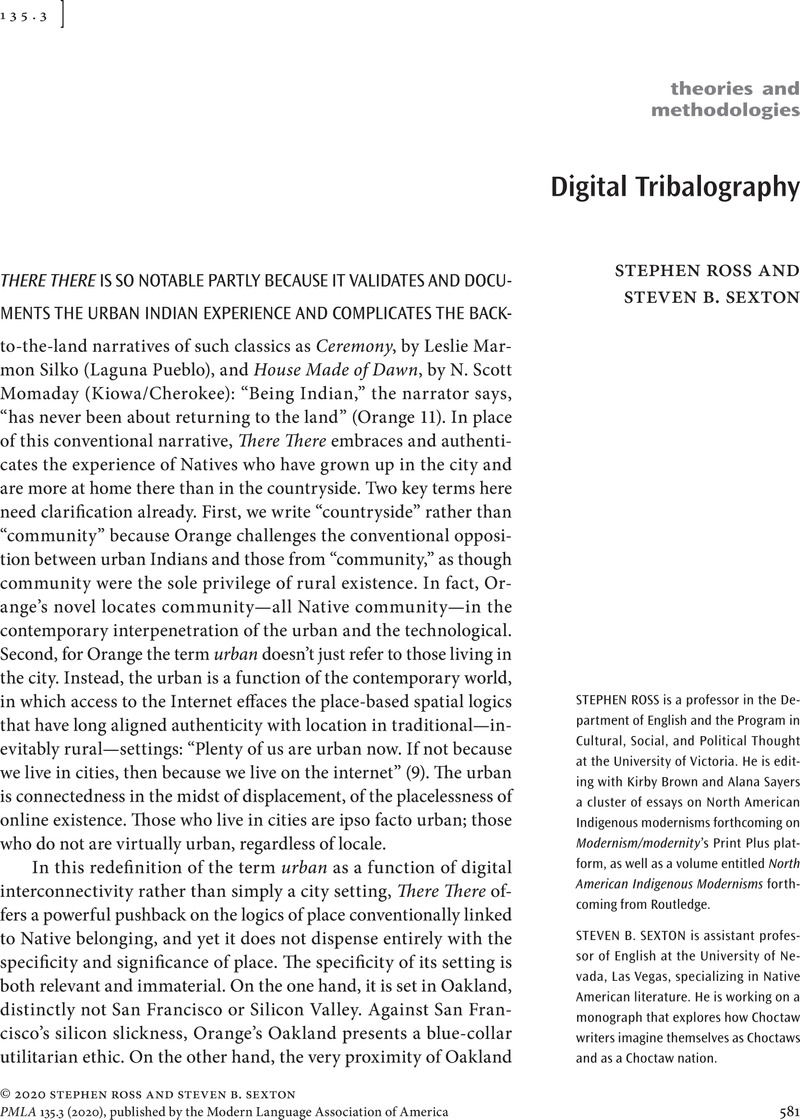No CrossRef data available.
Article contents
Digital Tribalography
Published online by Cambridge University Press: 23 October 2020
Abstract
An abstract is not available for this content so a preview has been provided. Please use the Get access link above for information on how to access this content.

- Type
- Theories and Methodologies
- Information
- Copyright
- Copyright © 2020 Stephen Ross and Steven B. Sexton
References
Works Cited
Bauerkemper, Joseph. “Assessing and Advancing Tribalography.” Introduction. Tribalography, special issue of Studies in American Indian Literatures, edited by Bauerkemper, Vol. 26, No. 2, Summer 2014, pp. 3–12.Google Scholar
Birchfield, D. L. How Choctaws Invented Civilization and Why Choctaws Will Conquer the World. U of New Mexico P, 2007.Google Scholar
Doerfler, Jill. “Making It Work: A Model of Tribalography as Methodology.” Studies in American Indian Literatures, Vol. 28, No. 2, 2014, pp. 65–74. Project Muse, doi:10.1353/ail.2014.0014.CrossRefGoogle Scholar
Duarte, Marisa Elena. Network Sovereignty: Building the Internet across Indian Country. U of Washington P, 2017.Google Scholar
Howe, LeAnne. “Blind Bread and the Business of Theory Making, by Embarrassed Grief.” Reasoning Together, edited by Womack, Craig S. et al., U of Oklahoma P, 2008, pp. 325–39.Google Scholar
Howe, LeAnne. “The Story of America: A Tribalography.” Clearing a Path: Theorizing the Past in Native American Studies, edited by Shoemaker, Nancy, Routledge, 2002, pp. 29–48.Google Scholar
Lyons, Scott Richard. X-Marks: Native Signatures of Assent. U of Minnesota P, 2010.CrossRefGoogle Scholar
Meland, Carter. “Talking Tribalography: LeAnne Howe Models Emerging Worldliness in ”The Story of America' and Miko Kings.“ Studies in American Indian Literatures, Vol. 6, No. 2, 2014, pp. 29–39. Project Muse, doi:10.1353/ail.2014.0022.Google Scholar
Ortiz, Simon. “Towards a National Indian Literature: Cultural Authenticity in Nationalism.” MELUS, Vol. 8, No. 2, 1981, pp. 7–12. JSTOR, www.jstor.org/stable/467143.CrossRefGoogle Scholar
Rader, Dean. Foreword. Choctalking on Other Realities, by LeAnne Howe, Aunt Lute Books, 2013, pp. i–vii.Google Scholar
Romero, Channette. “Expanding Tribal Identities and Sovereignty through LeAnne Howe's ‘Tribalography.‘” Studies in American Indian Literatures, Vol. 26, No. 2, 2014, pp. 13–25. Project Muse, doi:10.1353/ail.2014.0020.CrossRefGoogle Scholar
Vizenor, Gerald. Manifest Manners: Postindian Warriors of Survivance. Wesleyan UP, 1994.Google Scholar
Wolfe, Patrick. “Settler Colonialism and the Elimination of the Native.” Journal of Genocide Research, Vol. 8, No. 4, 2006, pp. 387–409.CrossRefGoogle Scholar


